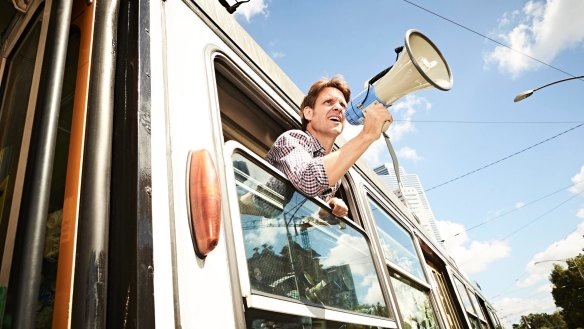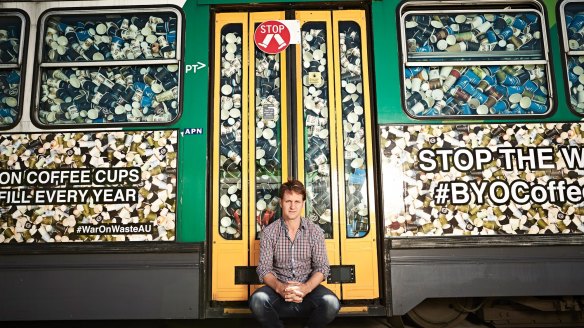The Chaser's Craig Reucassel busts huge coffee myth in War on Waste
Most of us throw our takeaway cups in the recycling bin. Which is terrible for our environment, as <i>The Chaser's</i> Craig Reucassel explains in his new show.

Most Melburnians groan at the sight of a crowded tram. But this one – its passengers pressed against the windows – provokes curious smiles. Not least because The Chaser's Craig Reucassel is hanging out the side, yelling into a bullhorn.
On the steps of the Old Treasury building, tourists ask each other: how many are in there? The answer is more than 50,000 (takeaway coffee cups, that is). Every half-hour, Australians send another tramload to the tip. All up, we burn through 1 billion each year.
On Spring Street, Reucassel vox pops pedestrians. Nearly all are shocked to learn the cups they diligently "recycle" end up in landfill.
It's something Reucassel analyses in War on Waste, his new three-part ABC series, set to debut in May. Loosely based on a BBC program, it focuses on food, fashion, plastic, recycling and coffee cup waste. Topics chosen not in Aunty's boardrooms, but the depths of suburban wheelie bins.
To get an idea of what ordinary Australians are wasting, Reucassel picked 10 neighbours and sifted through their rubbish. "We went, 'These are obviously the problems, lets try to figure out how to reduce them'."
But publicly shaming individuals into being greener is not his style, if his coffee cup segment is any guide. After all, why wouldn't people assume they can be recycled? They look and feel like cardboard (which they are – mostly). But the thin plastic lining that contains the hot beverage will outlive everyone on earth right now. If they get into the water, marine animals choke on them. Not to mention all the trees, water and electricity required for their production. All for something we use once, for a few minutes.
Coffee's become such an obsession, but it's changed over the years; everyone just takes it away.Craig Reucassel
"I just tweeted, 'If it's single-use, it's probably bad'. I put 'probably' there because I knew some smart-arse would tweet, 'What about condoms?' And sure enough, the first reply was: 'What about condoms?'."
Some might counter his coffee cup claims by pointing to "greener" versions that use plant-based linings instead of plastic.
"They're better in some ways [but many] have an inner lining that's made of corn starch, that can only bio-degrade in commercial-level compost. They don't bio-degrade in your home compost ... they have to be separated from the rest of the waste treatment. There are so many different cups out there, it makes it a nightmare."

Many cups bear other recycling boasts. Look closely, and you might find it's only the lid or cardboard sleeve that can be reprocessed. Or perhaps they contain recycled materials.
"Coffee's become such an obsession, but it's changed over the years," Reucassel says. "Everyone just takes it away; which wasn't the way coffee used to be." Indeed, which Italian immigrant foresaw their espressos mutating into caramel-mudslide lattes, in cups the size of vases, with the drinker's name mis-spelled in texta on the side? For those addicted to their takeaway hit, Reucassel literally pulls the answer out of his bag: a reusable cup. Some cafes even give customers a discount if they provide their own cup.
"It's better to avoid the waste in the first place than trying to recycle it," he says. "The message is definitely to bring your own cup."
